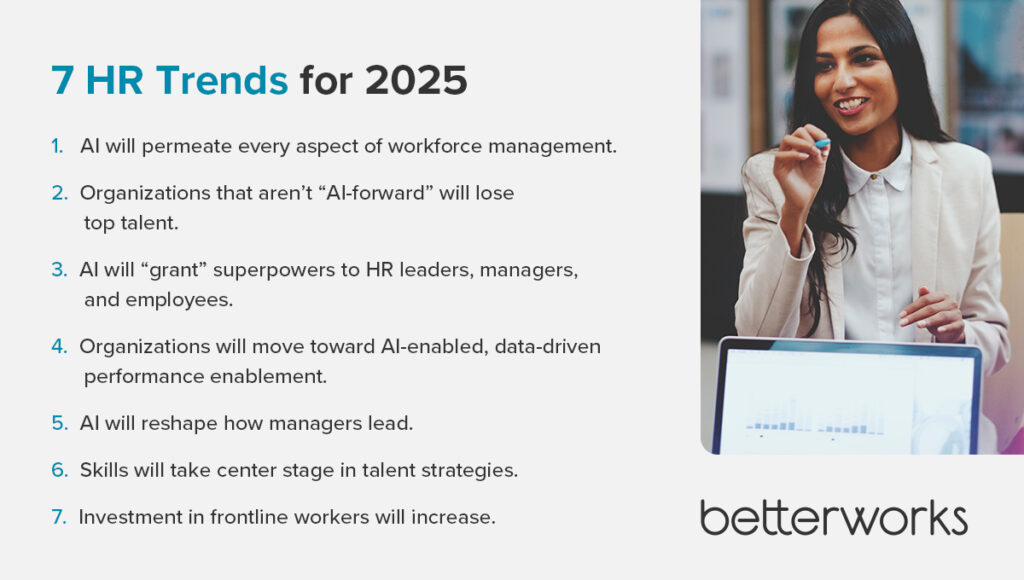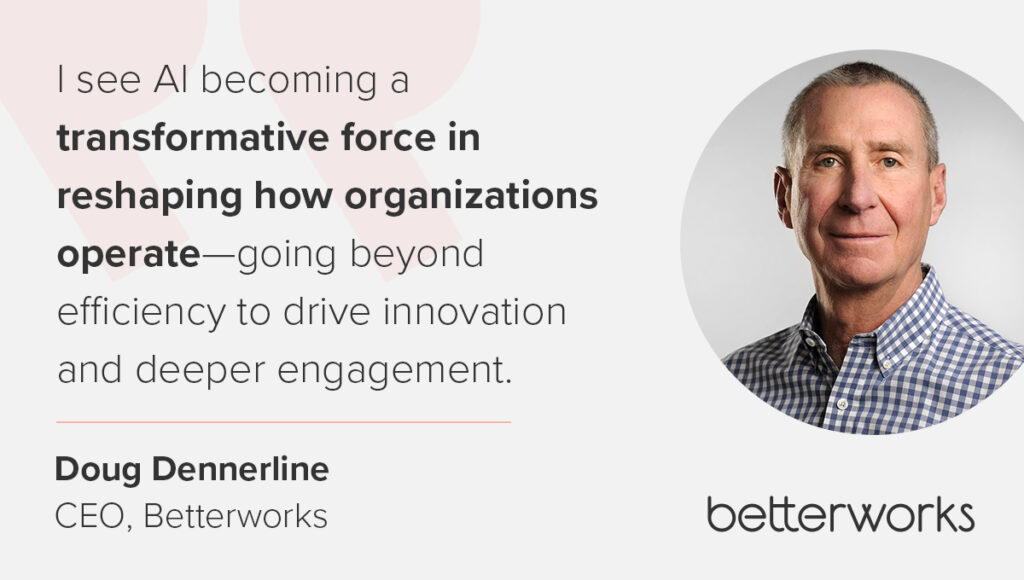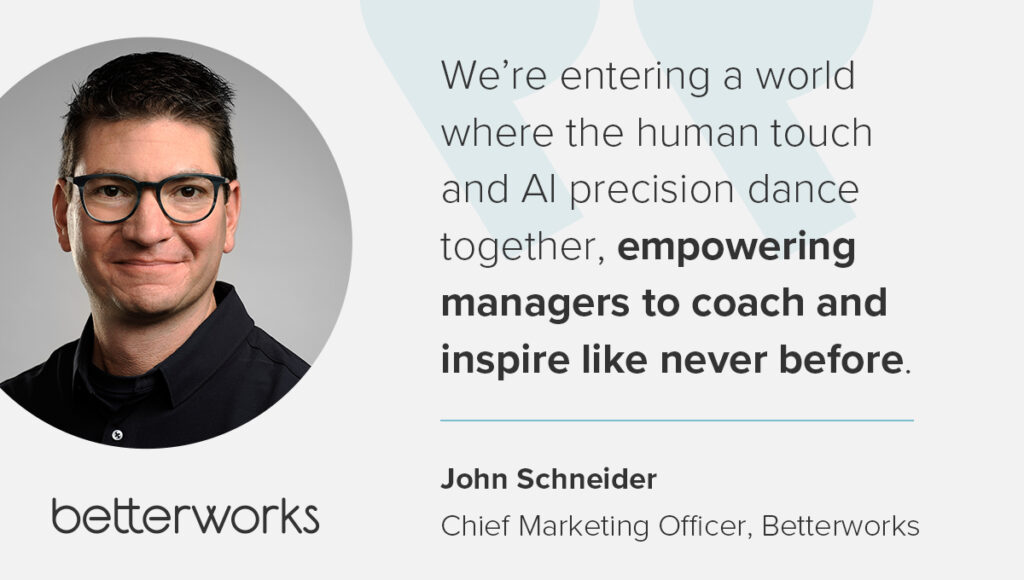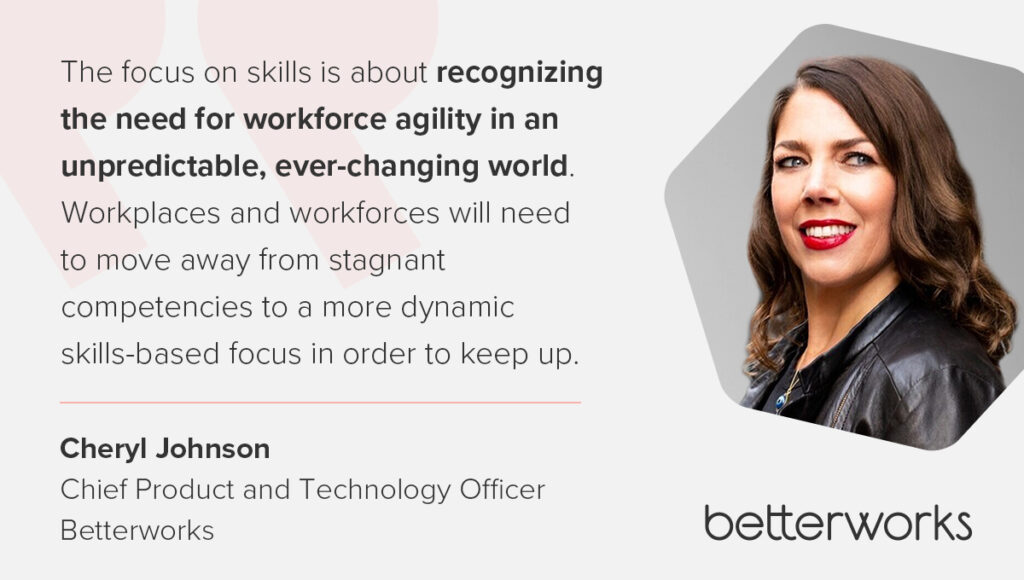- 2025 HR trends on the menu
- HR trends that will come off the menu
- A deeper dive into HR trends for 2025
- AI will permeate every aspect of workforce management
- Organizations that aren’t “AI-forward” AI will lose top talent
- AI will “grant” superpowers to HR leaders, managers, and employees
- Organizations will move toward AI-enabled, data-driven performance enablement
- AI will reshape how managers lead
- Skills will take center stage in talent strategies
- Investment in frontline workers will increase
- HR takeaways for a successful 2025
The HR trends in 2025 that we foresee reveal that AI will dominate the landscape for HR, corporate leaders, and employees — filtering into nearly every aspect of work and workforce management. HR leaders who proactively implement key AI initiatives to improve employee experience, skills development, and performance stand to gain the greatest benefits from the AI revolution. Holding back is no longer an option for organizations that wish to retain the best talent and make strategic, data-driven decisions that influence everything from employee development, to workforce planning, to manager effectiveness.
Our 2024 HR trends anticipated the rise of AI in HR processes as a positive force that would drive workplace efficiency, employee experience, and HR’s strategic value. We also foresaw a push toward skill-based development and the acceleration of strategies to close the skills gap. This year will be 2024 on steroids. If AI was the “appetizer” last year, it will be the main course in 2025.
2025 HR trends on the menu
The degree to which these HR trends take hold and grow will depend on how quickly organizations adopt an open mindset and commitment to AI experimentation and learning, and establish the policies and frameworks that enable AI transformation to take root internally. But we are certain of one thing: Organizations that hold back will lose top talent and competitive muscle because AI capabilities are rapidly improving and evolving. Early adopters and innovators stand to make large gains in a short time period, eclipsing their slower-moving industry peers.
- AI will permeate every aspect of workforce management including retention, identification of internal talent, skills development, and performance management.
- Companies that lag in AI adoption will lose top talent to companies that provide AI tools to streamline work and deliver greater opportunities for building AI skills and career advancement.
- AI will “grant” superpowers to HR leaders, managers, and employees alike, giving them the ability to predict future workforce needs, vastly reduce bias, improve employee engagement, increase retention, boost efficiency, and address skills gaps, to name a few.
- Organizations will move toward AI-enabled, data-driven performance enablement that will be efficient, drive higher engagement, and promote strategic business growth.
- AI will reshape how managers lead, transforming them from overburdened taskmasters into empathetic, strategic leaders.
- Skills will take center stage in talent development strategies, as companies leverage AI to remain agile in a period of unprecedented change.
- Investment in frontline workers will increase due to a dearth of talent, leading to greater interest in technology solutions to help alleviate the talent pinch.
Before diving into these key HR trends in greater detail, let’s take a quick look at HR practices and trends that we expect — or at least hope — will decline or die out in 2025.
HR trends that will come off the menu
- Old-fashioned, backward-focused, and compliance-driven performance management and performance reviews: “The idea that performance management exists solely to evaluate past performance will be turned on its head in 2025,” says Betterworks CEO Doug Dennerline. “Organizations that stick to annual performance reviews risk disengaging employees and missing valuable development opportunities,” adds Betterworks VP of HR Transformation, Jamie Aitken.
- Return to office (RTO) policies: “These rigid mandates are causing talented people to leave jobs they genuinely enjoy, often placing managers in difficult positions where they have to bend policies to offer the flexibility their teams need, but the company doesn’t officially support,” Doug explains. “Flexibility isn’t a perk — it’s an expectation.”
- Walled gardens in HR tech: “Organizations are focused on improving the employee experience and are demanding more from the technologies they use, including a seamless experience across technologies, especially for the employee,” says Betterworks Chief Product and Technology Officer Cheryl Jonson. “I expect to see more vendors focusing on interoperability in the coming year.”

A deeper dive into HR trends for 2025
Like the development of the integrated circuit, the advent of the Internet, and personal computing, generative AI is completely changing the way we think, communicate, interact, and work. But unlike its technological predecessors, generative AI represents a paradigm shift that will be orders of magnitude bigger because of the abundance of AI use cases, generative AI’s ability to learn and analyze patterns to create new content, and agentic AI, which can rapidly learn, adapt, and make complex decisions independent of humans.
AI will permeate every aspect of workforce management
“Imagine an HR landscape where decision-making isn’t just faster but smarter—where insights arrive free from bias and perfectly timed to support the most pivotal choices,” posits John Schneider, Betterworks chief marketing officer. “AI doesn’t simply automate; it illuminates.”
The pace of AI innovation is unprecedented, and its ability to make work more meaningful, strategic, and connected is just beginning to unfold according to Doug: “I see AI becoming a transformative force in reshaping how organizations operate—going beyond efficiency to drive innovation and deeper engagement. AI will play a critical role in uncovering hidden opportunities, whether it’s identifying untapped talent, forecasting workforce needs, or crafting highly personalized employee experiences that foster retention and growth. More and more companies will incorporate AI into their solutions to simplify complex HR processes and make results more actionable.”

Organizations that aren’t “AI-forward” AI will lose top talent
“The ability to leverage AI effectively will be a defining factor in attracting and retaining the best people,” says Betterworks COO Andrea Lagan. Employees—especially high performers—are increasingly drawn to workplaces that empower them with cutting-edge tools and opportunities for growth. AI can streamline workflows, personalize development paths, and create a more engaging work environment. “If companies lag in adopting AI advancements, they risk being perceived as stagnant, which will drive their most ambitious talent to seek opportunities elsewhere,” Andrea explains.
AI will “grant” superpowers to HR leaders, managers, and employees
Savvy HR leaders stay attuned to their workforce—understanding their needs, challenges, and capabilities. Andrea notes that most leaders say they’re focused on equipping employees to excel in ways that drive business success. Key questions include: Can employees effectively collaborate with leaders and teammates in hybrid or remote settings to hit strategic goals? Are leaders spotting top talent for key roles or projects? How can they proactively mitigate attrition risks? “The answer lies in AI,” Andrea explains. ‘AI-powered tools elevate collaboration, optimize talent strategies, and provide actionable insights, making them indispensable for future success.”
Managers often lack the training and technology tools to coach employees effectively, relying on outdated systems that silo learning and development from real-time performance data. “Generative AI is set to revolutionize management coaching by weaving together disparate data sources into one coherent ecosystem,” John explains. “This approach transforms the performance management system into the hub for comprehensive talent profiles, skill assessments, and actionable development goals. With AI-driven insights, managers can move from being task-focused supervisors to strategic talent enablers.”
When employees can access tools and resources that level the playing field and streamline their workflows—regardless of their role or location—they can focus on what truly drives impact, Andrea says. AI can enable employees to work equitably and efficiently while also fostering a culture of continuous innovation. If organizations create an environment where experimentation and innovation — along with the occasional failure — are both encouraged and celebrated, they will “unlock their employees’ potential in ways that lead to greater engagement, retention, and overall success,” Andrea says.
Organizations will move toward AI-enabled, data-driven performance enablement
As companies look to optimize workforce investments and increase employee engagement and satisfaction, they will refocus on driving performance enablement, and AI will play a pivotal role in performance management improvements.
The days of using performance management primarily to evaluate past performance and determine compensation are numbered. “Forward-looking performance management is the new gold standard,” Doug says. “AI will redefine how organizations manage performance, feedback, and employee development—becoming a true “co-pilot” in workforce management that enables leaders to address biases, streamline feedback, and predict future workforce needs more effectively.”
For example, AI tools like Betterworks’ Feedback Assist are reducing the time managers spend on performance reviews by up to 75% and supercharging feedback cultures. In 2025, these innovations could evolve to anticipate organizational shifts, identifying and closing skill gaps before they impact business outcomes.
Continuous and flexible performance enablement focuses on agile goal-setting, regular feedback loops, and real-time adjustments, aligning individual growth with organizational priorities — moving beyond annual performance reviews. “Given the high turnover rates and employee demand for meaningful development, performance enablement tools will support ongoing, collaborative growth,” Jamie explains. In addition, she says, these tools will increasingly “decouple compensation decisions from performance reviews, fostering a focus on personal development and skills acquisition rather than mere annual performance.”
Cheryl notes that the need for more dynamic and data-driven approaches to performance management that leverage AI, continuous feedback, and skills analysis will help drive the shift.
AI will reshape how managers lead
The displacement of middle managers—called “The Great Unbossing”—continues. While Betterworks views this as shortsighted, “it’s putting even more pressure on remaining managers to make a bigger impact on the bottom line,” Cheryl says.
Among remaining managers, many are rightly considered the backbone of high-performing teams, but “the backbone is brittle, burdened by outdated tools and superficial training,” John explains. “They’re handed the keys to the kingdom but left to navigate with century-old maps, their potential limited by disconnected systems that neither inform nor empower.”

In an organization where AI serves as a co-pilot, however, managers will have the time and capabilities to lead, coach, and cultivate talent. By automating routine tasks, identifying skill gaps, and aligning goals intelligently, AI enables managers to refocus on high-impact activities. They will be empowered to blend their own judgment with AI-driven insights, leading to more effective coaching and greater impact. “This isn’t just an enhancement; it’s a paradigm shift,” John says. “We’re entering a world where the human touch and AI precision dance together, empowering managers to coach and inspire like never before.”
In this new reality, AI transforms performance management into an intelligent guide seamlessly integrated with tailored learning systems. “Generative AI whispers the right insights at the right moment,” John adds. It turns data into actionable gold, spotting overlooked talent, illuminating potential, removing bias, crafting customized development plans, and ensuring that every contribution is leveraged. “Managers can now see their employees as unique, evolving talent—ensuring every contribution is recognized and maximized,” John says.
Skills will take center stage in talent strategies
Skill building and the use of AI in identifying and analyzing skills, mapping skills to strategic business objectives, suggesting organizational and individual skills to be built, and tracking skill development will continue to gain traction in 2025 as companies seek to ease the skills shortage.
“The focus on skills,” Cheryl says, “is about recognizing the need for workforce agility in an unpredictable, ever-changing world. From global macroeconomic and geopolitical shifts to the rapid evolution of technology, the environment in which we operate is constantly transforming. Workplaces and workforces will need to move away from stagnant competencies to a more dynamic skills-based focus in order to keep up.”

Investment in frontline workers will increase
With ongoing labor shortages of frontline workers and high turnover rates, these employees are in demand. The result? An “unexpected resurgence of interest and investment in frontline workforce management solutions,” according to Cheryl: “Many in the industry are focused on the needs of knowledge workers in particular as we navigate remote and hybrid work, AI at work, etcetera. But realistically, it’s the industries that employ the most frontline workers that are feeling the talent pinch most acutely. There is potential for outsized impact, especially leveraging AI.”
HR takeaways for a successful 2025
What can HR leaders do to prepare for the upcoming year? Betterworks leaders share their insights.
Jamie: Enhance data literacy and data storytelling capabilities across HR teams, use predictive analytics for strategic workforce planning, and integrate data sources to gain a holistic view of talent health, skill distribution, and potential risks within the workforce.
Additionally, focus on soft skills. High performance involves collaboration, empathy, and other soft skills not easily quantified in traditional productivity metrics. Value these contributions more, seeing high performance as a combination of teamwork, influence, and adaptability in addition to individual output.
Doug: Don’t cling to “business-as-usual” methods when it comes to performance management. Those who do will find themselves outpaced by organizations that view performance as a catalyst for innovation, not a checkbox for HR compliance.
Andrea: When it comes to well-being, employees will expect their organizations to go beyond traditional benefits, seeking a more holistic approach that integrates mental health support, work-life balance, and equitable workloads into daily operations. AI and data-driven insights will play a critical role here, enabling organizations to identify stress points and tailor well-being initiatives in real-time.
As competition for talent heats up, long-term retention hinges on personalization, empowerment, and innovation. Employees expect tailored experiences—whether through personalized career development, AI-driven learning paths, or benefits that align with their needs. Empowerment means equipping employees with modern tools, equitable resources, and autonomy, alongside the flexibility and clear communication they need to thrive. Foster a culture of innovation and loyalty by encouraging curiosity, creativity, and the use of cutting-edge technologies to tackle meaningful challenges, making employees feel valued and energized.
Ready to learn more about how to elevate your people and performance in 2025? Register for our virtual event, EmpowerHR.
Transform workforce planning into a living, breathing strategy


